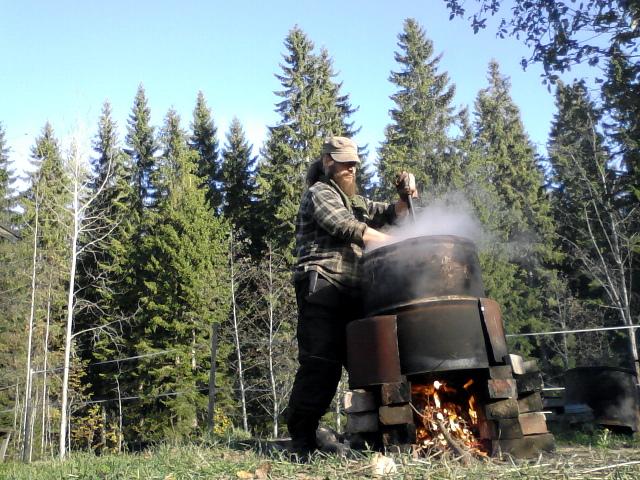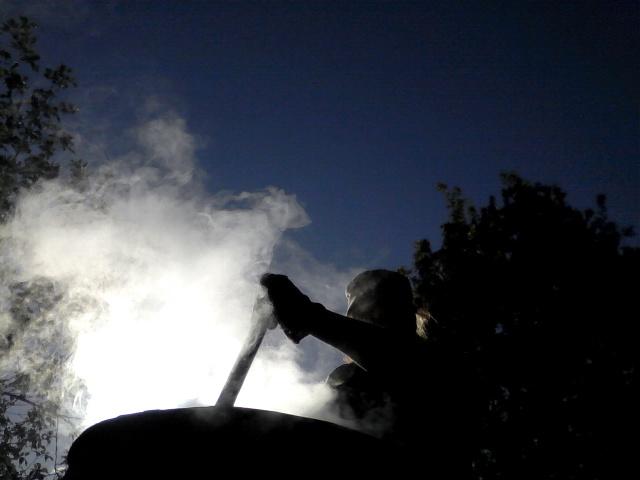
Cooking paint
Finally I have some free days at home, no external timetables and a nice sunny autumn weather. In the morning the lawn was covered with frost, so in the night it has been below freezing, but with absolutely no clouds on the sky it seems like it will be a pleasantly warm day. Well, I remember that earlier I said that during these days when I have no customers for massage, I could write an extended example story for Tarupaja. Then, on the other hand, after I paid all of my bills, there was practically no money left on my bank account - and the milling company has asked for new features for the custom office solution, so maybe I'd better do some coding as the company will pay me for what I do. Hmm. I see the new siding and I want it painted red, no plain wood anymore I want them turn red! I mean, these might be the last sunny and warmish days of this autumn, I just can't waste them coding indoors. So I will cook traditional red paint called punamulta.
Punamulta is some sort of earth pigment, a special kind of clay which is rich of iron oxide. It has been used in Finland since the ancient times - there are some stone-age paintings on cliff-sides, and they have punamulta as a pigment. A small house painted red with punamulta is the iconic picture of Finnish agrarian life - a symbol of peaceful happy living. Earlier in the summer I mentioned my father that I'm going to paint my house using punamulta, and he said that in their storehouse there is an old wooden barrel with punamulta powder in it. Nobody knows for sure how old the barrel is - I'd guess it dates back to 1940's or 50's. Well, I got the barrel with the pigment and transported it to my place.
I have never before made paint, but I copied a recipe from a book. The basic recipe consists of water, rye flour and the pigment. But it is recommended to add iron sulfite (it helps the timber to last the weather without rotting), and linen seed varnish (to make the the paint easier to paint), and some salt (so that the rye in the paint won't go bad if you need to store the paint before painting). I was bit unsure where to get iron sulfite from - if it is something used only for traditional paints, then it might be that I have to drive to Tampere for shopping. I asked a local painter, and she suggested me to ask the local paint store. (Silly me, sometimes I just don't realize that the most obvious solution would be to visit a store and ask if they have what I need...) Well, the salesperson at the local paint shop knew instantly what I was talking about, he went to one of the shelves and picked up a 4kg package of iron sulfite. He also had the varnish, and a set of brushes specially designed for traditional paints. And a recipe for punamulta paint, he kindly photocopied the recipe for me. Like, the village of Vilppula is smallish, but it is extremely nice to have this kind of special stores selling quality stuff with expertise.
As the paint is prepared by nearly-boiling the ingredients for several hours, I needed a big enough container. Both of the recipes suggested using an old metal barrel. Several weeks ago I asked one of my massage customers if he happens to have a spare barrel. Sure thing. I exchanged that empty barrel for 40 minutes of massage. At home I used a side-grinder to cut the other end of the barrel open, making a 150 litre kettle. Now, as I was reading the recipes again, I realized that I only need something like 35 litres of paint. So I cut the barrel smaller. I built a simple square fireplace out of old bricks, and placed thin flat stones on top of the each corner. Then I put the barrel standing on top of the flat stones, so that there was two inches of empty space under the bottom of the barrel. Next I placed the cut away strip of the barrel around the bottom of the barrel, to capture more of hot air around the barrel. Both of the recipes suggested using a layer of fireproof wool around the barrel, as the extra insulation makes it easier to keep the paint near boiling. But I decided to try without extra insulation.
I poured 5 litres of cold water into a bucket, and mixed 2.25 kg of rye flour into the water. Then I poured 25 litres of water into the barrel, and lit a fire under the barrel. My simple make-shift construction seemed to be very efficient - the water was brought to boil while I was measuring the iron sulfite. Like, it was two times faster than I thought. I added 3 kg of iron sulfite into the hot water, and stirred the mixture with an old wooden paddle. Then I added the rye flour which was already mixed with cold water. More stirring, to make the rye flour to mix evenly with all of the liquid. The recipe said that the mixture needs to be near boiling for 3 hours or so, being stirred every now and then. At this point I quickly made myself some sandwiches, and for a while I repeated eat - stir - eat - stir -cycle.
The punamulta powder had been stored for decades, and there was all kind of rubbish resting on top of the pigment powder. Pine needles, a bottle cap, small feathers, scarps of paper and the like. So I decided to run the pigment through a sieve. I needed about 8 kg of the pigment. So, now I was repeating sieve - stir - sieve - stir cycle until I got a bucket full of pigment - which was 8 kg. I poured 2 litres of linen seed varnish into the paint mixture. And stirred it. I filled the drinking water bucket for the horses. I stirred the mixture. I posted some photos on facebook. And again I stirred the mixture. And after all this it was already two and a half hours. So, thirty minutes before I can add the pigment. At this point the mixture was boiling a little, and I let the fire wear down to ambers. I poured some water into an aluminium kettle, and placed the kettle on top of the hot ambers. Soon the water boiled, and I made myself a mug of coffee. There I sat watching the steam rising from the mixture, sipping my coffee and being glad.
One of the good things about punamulta paint is that it is quick to apply - only one layer is enough. And then, after decades, if you need to re-paint the walls, you don't have to remove the old paint, as you can just apply a new layer of top of the old one. Hmm, 35 litres of a ready paint would cost something like 100 € or a bit more, so let's calculate: I got the pigment for free, and maybe it is OK to count the barrel as free, too. The iron sulfite was 8 €, the varnish was 16 €, the rye flour was 3 €, and the salt was 1 € - which makes 28 €. And a day of work, but that's fine =) Well, but where was I? Yes, the paint had been boiling for 3 hours, so it was time to add the pigment into the mixture. And salt. After that the mixture is let to simmer for half an hour.
I tested it by dipping a piece of board into the paint, and used a scrap of paper to spread the paint. The colour looks just the way I like. And in the evening sunlight the paint dried quickly. I wiped it with my finger, but my finger didn't get smeared by the pigment - which is a sign that the paint is ready. All of the pigment stays where it is painted. Good! For a moment I felt like starting to paint right away, as there were still several hours of daylight left. But I decided to postpone it for tomorrow. If I start tomorrow after sunrise, there will be the whole warmish day - which should be enough for the paint to start drying before the coming night makes the temperature to fall below freezing. Yes, I know, it would be wiser to paint in the spring when the temperatures are warmer. But still, I believe this crisp autumn air is good enough for the paint to dry properly. So, now I need to sleep for the night and continue tomorrow. (Maybe later on this week I can drink coffee and work long days to get the coding done. Or something, whatever, I have a feeling that things will work out.)




Add new comment